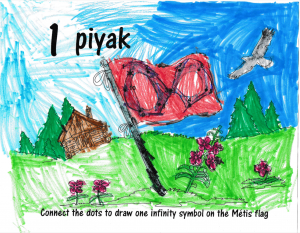14 Count to Ten: The Métis Way
Michelle Souliere
Contributor’s Biography:
Michelle Soulière is a fourth-year student at Kwantlen Polytechnic University. They intend to become a French immersion elementary school teacher and integrating Indigenous Knowledges in the classroom. They are self-identified Métis and passionate about advocating for the Indigenization of the curriculum.
Resource Overview
Weblink:
Cowichan Valley School District. (2021). Printable resources. Indigenous education. http://ined.sd79.bc.ca/curriculum-resourcess/printable-resources/
Additional access point to a Weblink PDF:
Grade Level: Kindergarten
Description:
The resource consists of ten printable colouring pages which depict the numbers one through ten. Each page has a spelled-out number in Michif, the language of Métis Peoples’, as well as the numerical equivalence. There are also images of culturally significant items on each page, which correspond with the respective number. There are written instructions on the bottom of each page that indicate different activities that supplement the colouring pages. For example, the first page elaborates that the participant must “connect the dots to draw one infinity symbol on the Métis flag” (Cowichan Valley School District,2021, p. 3). The resource focuses on numerical curricular core competencies. It has activities that pertain to fine and gross motor skills, such as cutting images on the pages with numbers six and seven while integrating culturally significant items.
Significant Indigenous Knowledge:
Necessary Prior Knowledge:
Before using this resource, it is recommended that the educator becomes familiar with Michif, the language of Métis Peoples. To best articulate the Michif language respectfully, the educator should learn how to correctly pronounce each of the ten numbers from a Métis Nation member. A YouTube video with the proper pronunciation in the Michif-cree dialect can be found online. The educator should watch the video first but may also want to watch it with the participants. There is also an app that the educator can download on their smartphone which translates English to Michif. It is called the “Heritage Michif To Go.” and it can be found on your smartphones’ app or at their website.
This resource includes a page that requires the participants to circle the three ingredients of Pemmican. To do so, the educator must teach what the item is as well as the ingredients that hunters and gatherers use to create Pemmican. Métis Peoples would dry meat, dry berries, then pulverize them and combine with lard (Academic Kids, 2005). The food was very healthy, could last for years, and be brought anywhere since it was cut into small strips (First Peoples of Canada, 2007).
Another page requires participants to colour the “capote,” a coat worn by Métis People (Morris, 2020). The page tells participants to use the four colours to colour the coat. Thus, an educator needs to know the four colours and their significance. Red represents the lives lost in battle. Blue represents the spirit and soul. Green represents the land. Lastly, yellow represents future prosperity (Morris, 2020). The page with the number five depicts five beavers. The educator should know that the Métis people are the “Children of the fur trade,” and that Indigenous and European union’s often happened during fur trading. Educators must also know that Métis People were very skilled hunters and trappers (Fur Trade, 2018).
On page fourteen there are moccasins to be coloured in, which have beaded flowers embroidered onto them. The educator needs to know that Métis people were “The Flower Beadwork People,” well known for their intricate beadwork and brightly coloured floral motif (Morris, 2020). Lastly, the Red River Carts are pictured, and Métis People first fabricated them. To supplement the colouring page, promote literacy in the classroom, and elaborate on the cart, the educator can read a kindergarten grade-level book written by Indigenous Canadian Métis author Leah Marie Dorion named “A Red River Cart.”
Suggested Learning Activities
One of the possible activities geared for this age group could be a Science, Technology, Engineering, and Math (STEM) activity. The aforementioned book A Red River Cart by Leah Marie Dorion details how the Red River cart is made. It also describes the functionality and construction (Dorion, 2021). After reading it, the educator could ask participants what they would use to build their own miniature Red River carts. After hearing suggestions, the educator could gather supplies for the participants to construct small Red River carts. Some suggestions on supplies that could be used are bottle cap wheels, paper clips, egg cartons, Legos, paper, K-nex pieces, and elastics.
Another possible activity would coincide with the colouring of the fiddle on the page with the numerical number 8. There is an artistic component when colouring the page, and there is an opportunity to elaborate on the Métis jig and incorporate some physical education. The most popular jig is The Red River jig which is rooted in Métis culture. Métis dance while the fiddle is playing. Participants can dance along to the music. The activity would start with a short video explaining what the jig is and demonstrating some simple dance movements for participants. Additionally, the educator could integrate a literacy component into the activity. There are three books written by Wilfred Burton and Anne Patton that tell of Métis culture and how it is strongly rooted in the Métis fiddle and jig. Fiddle Dancer, Dancing in My Bones, and Call of the Fiddle include CD’s that have English and Michif versions of the stories as well as fiddle music (Burton and Patton, 2021). To ensure inclusiveness and encourage participation, there could also be optional music playing aspect. Participants could use a pair of spoons to play along with the music. Another video would demonstrate how to play musical spoons. Finally, the link to the Red River jig. The activity encapsulates art, music, and physical education.

Image by: Michelle Souliere BY-NC-ND (Attribution Non-Commercial No Derivatives)

